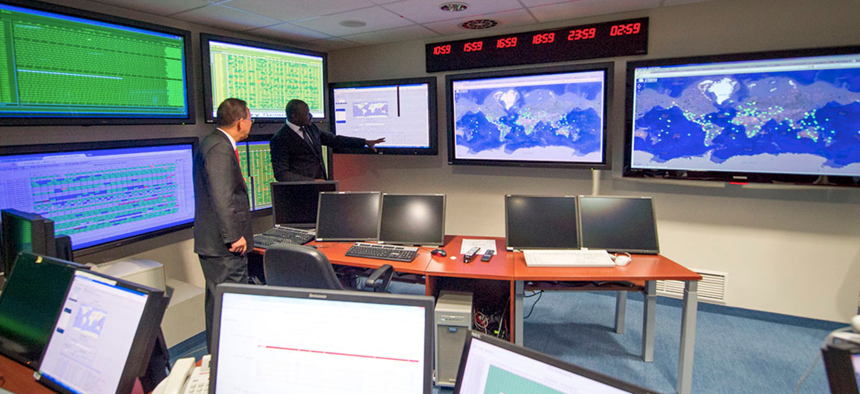
In recognition of the International Day Against Nuclear Tests, then-Secretary General of the United Nations Ban Ki-moon visits the Comprehensive Nuclear Test Ban Treaty Organization's operations center. Eskinder Debebe/UN
One Nuclear Step to Settle an Unsettled Age
The single most symbolic and practical move that states possessing nuclear weapons could make would be to ratify the Comprehensive Test Ban Treaty.
William Bullitt accompanied President Woodrow Wilson to Paris to negotiate an ambitious peace treaty after the carnage of World War I. Reflecting on the handiwork of vengeful allies in the Versailles Treaty, Bullitt prophetically declared, “This isn’t a treaty of peace… I can see at least eleven wars in it.” The victors in World War II did far better, establishing a progressive international order that fostered economic progress and helped prevent wars between major powers for over half a century.
This international order is under great strain, challenged by pervasive anxiety, growing inequality, regional flash points, anemic economies, and ceaseless refugee flows from wartorn areas. Lesser despots have fallen, opening up ungoverned spaces, while secular strong men have arisen in linchpin states like India, Egypt, the Philippines, Israel and Turkey. Confident leaders have also taken up residence in Washington, Moscow, and Beijing, promising to cure national ailments while building up military capabilities. There is an ominous feel and bellicosity in domestic politics and world events.
For the United States, it has been a long downhill slide since winning decisive victories in the Cold War and easily toppling Saddam Hussein. In retrospect, 9/11 was a major pivot point. Overreach followed. Subsequent ill-advised and ill-executed wars in Iraq and Afghanistan sapped America’s strength, treasury, and influence. President George W. Bush expanded NATO to Russia’s doorstep. His crusade to extend democracy worldwide is now a distant memory. Domestic cohesion has dissolved. Relations between major powers are strained, and U.S. alliances are shaky.
The greatest unsung achievement of the Cold War – diplomacy to control the nuclear arms race, reduce nuclear dangers and arsenals, and prevent mushroom clouds – has been forgotten. This body of extraordinary accomplishment – strategic arms reduction treaties, the Non-proliferation Treaty, and the Comprehensive Test Ban Treaty — is unraveling. Nuclear dangers are growing in Central Europe, East Asia, Northeast Asia, South Asia, and the Middle East.
Republicans on Capitol Hill now widely dismiss the value of diplomacy to reduce these dangers, and President Donald Trump could well accentuate them. He has put Iran “on notice” against flight-testing ballistic missiles – missiles not prohibited by the Obama administration’s verifiable accord designed to prevent Iranian production of nuclear weapons for fifteen years. As for North Korea’s flight-testing of an intercontinental ballistic missile, that “won’t happen” either, according to a tweet from the then-president-elect. Kim Jong-un is so unsettled about his ability to deter U.S. military action against North Korea that he still tests nuclear devices underground. Pakistan has the capability to produce more nuclear weapons every year than the entire North Korean stockpile, while harboring extremist groups that lash out at India. China has begun to deploy multiple warheads on its long-range missiles, soon to be followed by Pakistan and then India. Vladimir Putin brandishes nuclear weapons while making greater inroads in eastern Ukraine and destabilizing western democracies.
Related: Why Did Trump Pick a Fight with Putin Over the Nuclear Weapons Treaty?
The prophetic voices of our time might well be those of Mikhail Gorbachev and William J. Perry. Gorbachev, in an essay in Time magazine, bemoans “the militarization of politics,” arms buildups, and leaders that are bellicose, confused, or “at a loss.” Gorbachev warns that, “It all looks as if the world is preparing for war.” Perry warns against missiles and warheads that can be launched very quickly and that foster greater illusions of fighting and winning nuclear wars.
Gorbachev calls on leaders of states with nuclear weapons to declare, as he and President Ronald Reagan did in the 1985 Geneva summit, that “Nuclear war cannot be won and must never be fought.” Those who deride rhetorical gestures of this sort have forgotten, or didn’t experience the bellicose rhetoric and nuclear dangers of the early 1980s. This joint statement paved the way for these unorthodox leaders to break the back of the nuclear arms race.
Since the United States and Russia adhere to “first use” nuclear doctrines, Trump and Putin could usefully reaffirm this statement. The leaders of China, India and Pakistan – all poised to significantly expand their nuclear arms capabilities — could be encouraged to follow suit.
Important pledges can lose their effect unless backed up by deeds. The single most symbolic and practical step that states possessing nuclear weapons could take would be to ratify the Comprehensive Test Ban Treaty, which bans all nuclear testing for all time. Only three nuclear-weapon states have done so—Russia, Great Britain and France. The United States, China, and Israel have signed but not ratified the Treaty; India, Pakistan and North Korea haven’t even signed. All are needed for the Treaty to enter into force, lending new credence to global non-proliferation efforts. A chain of ratifications can begin with the United States, followed by China, India, Pakistan and Israel. President Obama couldn’t hope to gain the necessary Senate votes. President Trump could redefine himself and reduce nuclear dangers by doing so.
NEXT STORY: What Does Trump Want from Netanyahu?

